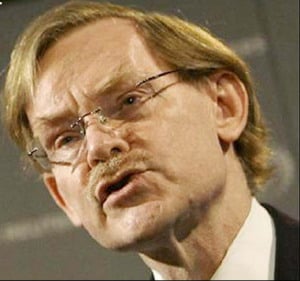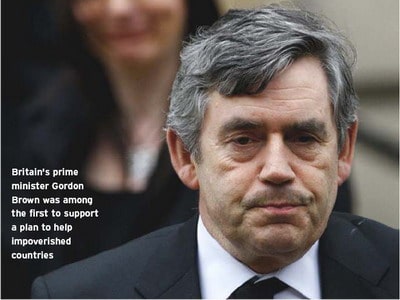HELP OR HINDRANCE?
Mounting concern over the economic prospects of the world’s poorest nations is encouraging developed nations to reassess their aid policies.
By Antonio Guerrero
 |
|
World Bank president Robert |
G-20 leaders appeared to agree. “We start from the belief that prosperity is indivisible; that growth, to be sustained, has to be shared; and that our global plan for recovery must have at its heart the needs and jobs of hard-working families, not just in developing markets but in the poorest of the world, too,” said a summit joint communiqué.
With British prime minister Gordon Brown becoming one of the first to support a plan to boost assistance to impoverished nations, the World Bank
was mildly encouraged. “The impact of the crisis on developing countries was put squarely on the agenda,” says World Bank managing director Ngozi Okonjo-Iweala. “We are pleased that developed countries saw developing countries as part of the solution. They can stimulate aggregate demand in those countries so they can help bring the world out of recession.”
Zoellick’s Vulnerability Fund aims to focus on three core activities: safety-net programs, infrastructure development and support for micro-lenders and small and medium-size businesses. The idea is not a new one. As far back as 2002, 22 of the world’s wealthiest countries, meeting at the Monterrey Conference, agreed to dedicate 0.7% of national income to aid impoverished nations, with the aim of raising the $195 billion the United Nations estimated was needed each year to effectively fight hunger and disease.
The idea also has its critics. Alvaro Vargas Llosa, senior fellow at the Independent Institute, a public policy research group in California, challenges Zoellick’s premise. “The World Bank naturally has a built-in interest in pushing this policy, but rich countries should understand that many of the premises on which this approach was based are not relevant,” he says. “For instance, it has been said that poor nations have problems accessing capital; the story of the last decade is exactly the opposite. Poor nations have attracted one in five dollars of [private] foreign capital, and the tendency, until the crisis froze capital flows recently because of the US economic mess, was toward even greater movement of capital from rich to poor nations,” he points out.
A World Bank Group document setting out its recommendations to respond to the financial crisis says strong banks and access to capital are crucial. “The IFC is adopting a multi-faceted approach to rebuilding financial infrastructure involving investment in the banking sector,” says the report. “The IFC Recapitalization Fund, in which IFC has invested $1 billion and Japan $2 billion, aims to provide additional capital for banks in developing countries to ensure they can support economic recovery and job creation.”
Zoellick expects some reluctance. “New investors will be unwilling to risk private capital until losses are transparently recognized and the future of the banks is clarified,” he said in a speech in London ahead of the summit. “Recoveries are likely to begin outside the financial sector, but they will be stymied without credit. The politics of allocating government funds to recapitalize banks is not easy. People do not like bankers, especially when they have to be bailed out. Yet leaders need to explain that a healthy Wall Street or City is necessary for a thriving Main or High Street.”
Mind the Gap
US Policy Reform Is Needed
 The Cato Institute, a Washington, DC-based public policy research foundation, appears to agree: “Although USAID lists South Korea and Taiwan as success stories of US economic assistance, those countries began to take off economically only after massive US aid was cut off,” its Handbook for Policymakers asserts. The organization contends donor nations should focus on boosting private sector competitiveness, tackling corruption, increasing access to education, providing access to capital and upgrading infrastructure, instead of relying on government-to-government assistance.
The Cato Institute, a Washington, DC-based public policy research foundation, appears to agree: “Although USAID lists South Korea and Taiwan as success stories of US economic assistance, those countries began to take off economically only after massive US aid was cut off,” its Handbook for Policymakers asserts. The organization contends donor nations should focus on boosting private sector competitiveness, tackling corruption, increasing access to education, providing access to capital and upgrading infrastructure, instead of relying on government-to-government assistance.
According to the Organisation for Economic Co-operation and Development (OECD), in 2007 the US dedicated 16 cents of every $100 earned to official development assistance, compared to the more than 90 cents contributed by Norway, Sweden and Luxembourg, all of which have exceeded the goal of dedicating 0.7% of national income to foreign aid. At 81 cents, Denmark and the Netherlands have also surpassed the goal, while Belgium and Finland are expected to do so next year.
Interestingly, the World Bank sees countries in Central and Eastern Europe as among the most vulnerable to the global downturn, despite having higher income levels than other developing regions. It argues that these countries have focused on integration with the EU and the global economy and that those links are now weakened. Furthermore, most banks in the region are owned by Western European banks, making them more vulnerable to external business decisions.
“The first thing that developing countries should do is stop looking to rich countries for answers,” says Ian Vásquez, director of the Cato Institute’s Center for Global Liberty and Prosperity. Vásquez feels trade is a more powerful tool to reduce poverty. “The discussion of foreign aid is a huge distraction from what matters in economic development,” he adds. “It’s unfortunate that in rich countries it is difficult to have a discussion on economic development without it devolving into a discussion on foreign aid.”
The Bill & Melinda Gates Foundation, a major global donor, disagrees. Though it lost a fifth of its assets in 2008, it plans to increase spending from last year’s $3.3 billion to $3.8 billion this year. “I hope the United States and other rich countries will continue to increase their aid,” wrote Bill Gates in a public letter released by the foundation this year, “and when I meet with political leaders, I encourage them to do so.” Zoellick would be proud.




